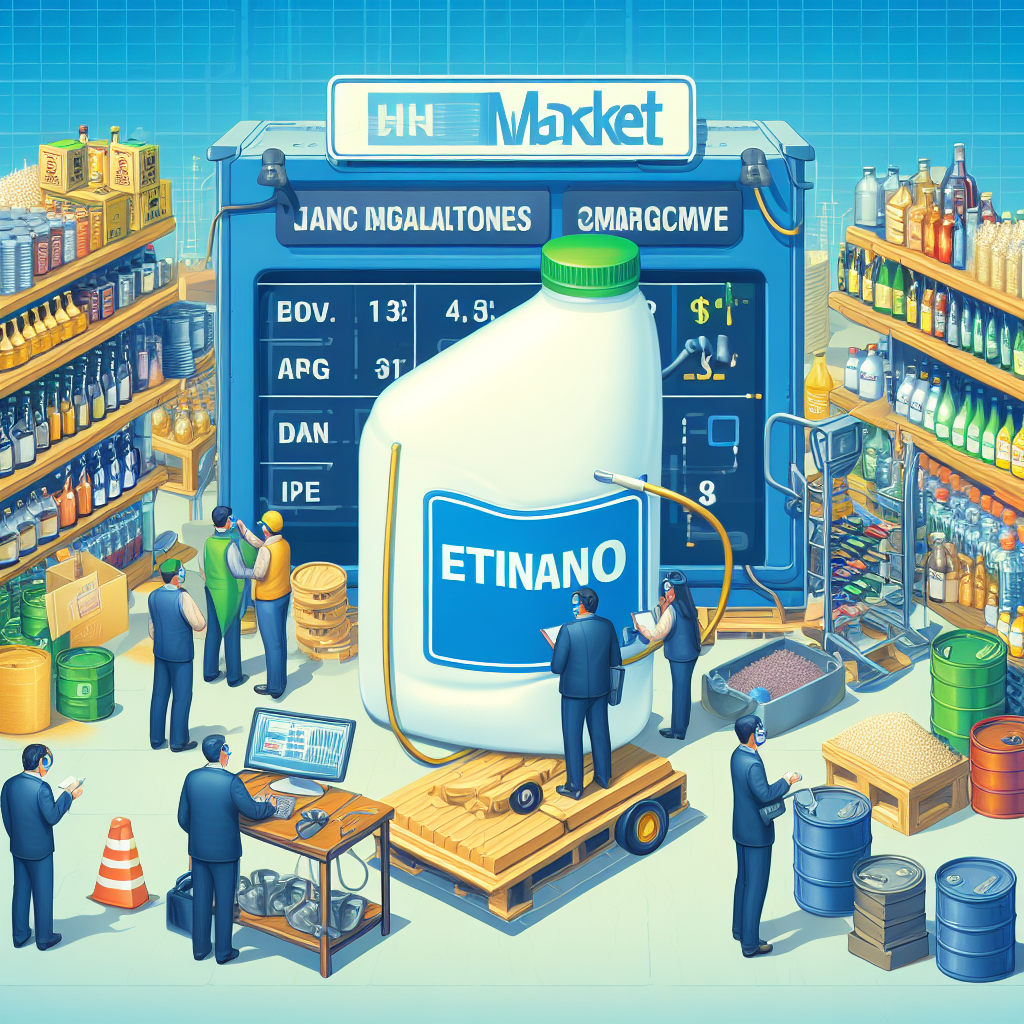The India Ethanol Market was valued at USD 6,512.27 million in 2023 and is expected to expand at a robust rate over the next several years, with a Compound Annual Growth Rate (CAGR) of 8.84% through 2029 and a projected USD 10456.98 million by that time.
This increase is being driven by ethanol, a renewable fuel made from different plant elements together referred to as “biomass.” India’s climate goals are in line with lower carbon emissions from ethanol due to its lower carbon intensity when compared to traditional fuels. One revolutionary factor has been the Indian government’s unwavering demand for ethanol to be blended into gasoline.
Competition Forecast and Opportunities In The Ethanol Market
To reduce greenhouse gas emissions and promote cleaner fuels, the Ethanol Blended Petrol (EBP) program was started in 2003 and requires the blending of ethanol with gasoline. The government’s pledge to incorporate 20% ethanol into gasoline by 2025 has increased ethanol production dramatically. Additionally, investment in the infrastructure needed for ethanol production has been encouraged by government support in the form of grants, subsidies, and incentives. Both the public and commercial sectors have shown interest in these incentives, which have increased output and capacity.

Furthermore, ethanol manufacturing gives farmers an additional source of income, boosting the economy of rural areas. Promoting ethanol strengthens energy security and benefits farmers by bridging the gap between the agricultural and energy sectors. Combined, these elements support the growth of the India Ethanol Market throughout the anticipated time.
Important Ethanol Market Factors Boosting Biofuel Demand for Sustainable Development
Global awareness of the need to shift to sustainable energy sources has grown recently as a result of worries about climate change, the depletion of fossil fuel supplies, and the pressing need to slow down environmental damage. With a focus on biofuels as a key element of its sustainable development strategy, India has emerged as a leader in the adoption of alternative energy options. Among the biofuels, ethanol has become more well-known as a greener and cleaner alternative to conventional fossil fuels.
The increasing demand for biofuels, particularly ethanol, is in line with India’s objective of sustainable development and signifies a significant change in the nation’s energy environment. In addition, energy consumption has significantly increased in India as a result of the country’s rapidly industrializing, urbanizing, and expanding population. India is highly dependent on imported fossil fuels to meet its demand, which exposes it to changes in world prices as well as geopolitical unpredictabilities.
Government Policies That Are Supportive Ethanol Market
Given the increasing global need for sustainable and eco-friendly energy methods, the Indian government has taken major steps to encourage the production and use of ethanol as a gasoline substitute. India has implemented several beneficial policies with a strategic focus on lowering carbon emissions, minimizing reliance on fossil fuels, and guaranteeing energy security.

Additionally, the government has actively encouraged the development and use of flexible fuel vehicles, which can run on a variety of mixtures of gasoline and ethanol Market. This gives consumers more options for gasoline and also raises the need for ethanol. Incentives and subsidies from the government given to sugarcane growers have also helped the ethanol market expand. Throughout the projection period, the combined effect of these government actions is anticipated to fuel ethanol consumption.
Read More Articles
Magna International: Underperforming the market is Magna International Inc.
India’s Transformation From a Cybersecurity Novice to a Digital Powerhouse
How To Develop Mindset and Achieve What you Want, Reach your Goals in 2024
Growing Demand in the Automotive Sector of Ethanol Market
The automotive industry, which is a major source of carbon emissions, is changing dramatically as efforts around the world to battle climate change and lessen its impact on the environment pick up steam. This change has increased demand for fuel substitutes that are greener and more sustainable, with ethanol emerging as a leader in the transformation of the automobile sector.
The demand for ethanol has been further stimulated by the introduction of laws and initiatives by the Indian government to support ethanol use in the automobile sector. To guarantee E20 availability by 2025, for example, fuel combined with 20% ethanol (E20) is being phased in starting in April 2023.
Fuel additives containing ethanol are frequently used to increase engine performance, lower emissions, and improve fuel efficiency. Together, these elements highlight the growing demand from the automotive industry, which is fueling the expansion of the India Ethanol Market during the forecast period.
Principal Ethanol Market Obstacles: Limited Knowledge
The use of ethanol as a fuel source may be hampered by consumers’ and industry’s lack of knowledge and comprehension of the fuel. This ignorance could impede the shift from conventional fossil fuels to more environmentally friendly substitutes like ethanol. Furthermore, misinformation about the advantages mixed gasoline with ethanol has for the environment and baseless worries about how it would affect car engines could hurt blended gasoline sales.

Limitations on Feedstock Availability of Ethanol Market
Weather, seasonal variations, and agricultural production fluctuations can affect the availability and cost of feedstocks such as maize and broken rice. Moreover, difficulties with feedstock availability may arise from the sugarcane industry’s high water requirements. These elements might make it more difficult to reliably get feedstocks, which could impact the market’s growth trajectory.
Important Ethanol Market Trends
Expanding Capacity
In recent years, India has been actively increasing its capacity to produce ethanol. Nowadays, locally grown commodities like cassava and sugarcane molasses provide the majority of the nation’s ethanol. The market’s potential has been highlighted by the influx of both domestic and foreign investment in new ethanol plants.
12,440 million liters are reached. It is projected that around 470 million liters of ethanol will be added with the start of significant new ethanol projects by a new interest subvention scheme, approved by the Food Ministry in January 2023. Notably, these initiatives include facilities based on grains and dual feedstocks.
The India Ethanol Market has been greatly impacted by the emphasis on renewable energy sources, such as ethanol. The need for ethanol as a renewable fuel source has increased as a result of the focus on green fuels. The use of biofuels in transportation is being fueled by government policies and incentives, as ethanol is seen as a cleaner and more sustainable fuel than fossil fuels.
The transition to more environmentally friendly fuels has also resulted in a wider variety of feedstocks used to produce ethanol. Aside from conventional sources like sugarcane and grains, the industry is investigating non-food feedstocks for ethanol generation, like algae biomass. Using green fuels has benefits for the environment, such as lower air pollution and greenhouse gas emissions.
Ethanol Market Category Analysis of Segmental Insights:
• From 2025 to 2029, the bioethanol segment is predicted to increase at the fastest rate—15.84%.
• Plants high in cellulose, such as sugarcane, sugar beet, and grains like corn, are the source of bioethanol.
India’s ethanol market is expected to increase throughout the projected period due to the following benefits:
• Bioethanol reduces CO2 emissions, minimizes waste formation, and lessens reliance on crude oil.
Ethanol Market Application Analysis:
• From 2025 to 2029, the fuel and fuel additives category is expected to increase at the fastest pace, 16.66%. The extensive usage of ethanol-based fuel and additives in a variety of applications, including fuel tanks, fuselage parts, wings, and engine parts, is responsible for this rise.
The India Ethanol Market is growing because:
• Ethanol-based fuel and additives are becoming more and more popular among consumers and governments as a cleaner, more sustainable fuel choice; they also offer resilience to temperature, pressure, chemical exposure, good bonding strength, and durability. Regional Analysis:
• From 2025 to 2029, the North Region is anticipated to develop at the quickest rate, 16.65%.
• Compared to other regions, this one has a large capacity for producing ethanol.
• More production facilities should open throughout the projection period, boosting the ability to produce ethanol.

• States like Punjab, Haryana, and Uttar Pradesh have an abundance of feedstock, which promotes the construction of ethanol production facilities in the North Region.
• Taken together, these elements support the growth of the North Region of the India Ethanol Market.
Important Market Participants
• Dalmia Bharat Sugar and Industries Limited; Simbhaoli Sugars Ltd.; India Glycol Limited; Triveni Engineering & Industries Ltd.; Shree Renuka Sugars Limited; Balrampur Chini Mills Limited; Dhampur Sugar Mills Ltd.; Bajaj Hindusthan Sugar Ltd.
Ethanol Market Report Purpose:
Market for Ethanol by Type:
• Bio Ethanol
• Purity-Based Synthetic Ethanol Market
Market for Denatured and Undenatured Ethanol by Raw Material:
Ethanol Market, By Application:
• Sugar & Molasses Based;
• Grain Based;
• Lignocellulosic Biomass;
• Algal Biomass
• Fuel and Fuel Supplements











